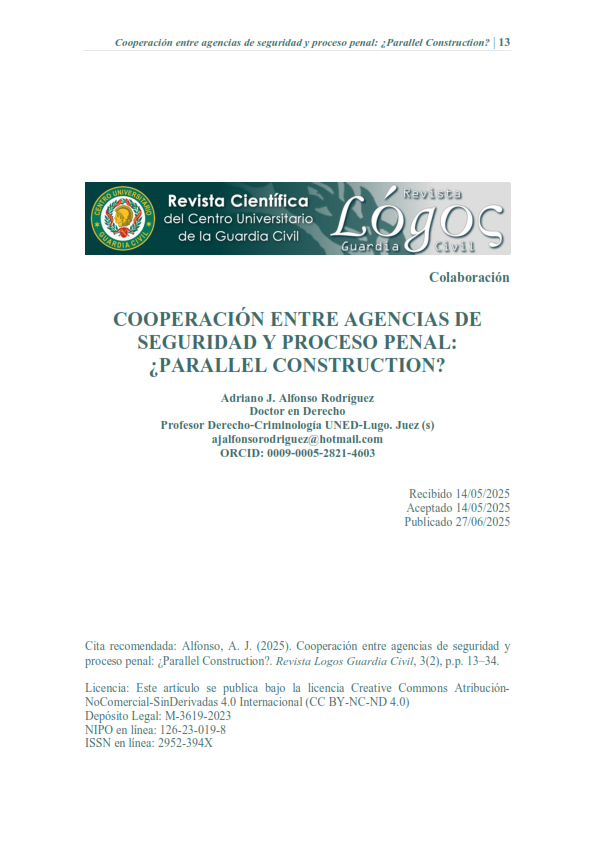Cooperación entre agencias de seguridad y proceso penal: ¿Parallel Construction?
Palabras clave:
Seguridad pública, Seguridad nacional, Policía, Servicio de inteligencia, Garantías procesalesResumen
La existencia de dos tipos de seguridad, la nacional y la pública, ha servido para apoderar a organismos diferentes sobre su prevención. Los servicios secretos han adquirido un protagonismo destacado en lo que respecta a la nacional, mientras que la pública implica la presencia de órganos policiales. Para el trabajo de vigilancia y protección es necesario en ambos casos vulnerar, autorizadamente, los derechos fundamentales. Sin embargo, no existe el mismo estándar cuando participan los servicios secretos que se ve rebajado por no estar investigando un hecho delictivo y la problemática comunicación de la información obtenida, cuando aquel aparece, a las fuerzas policiales ¿Es necesaria una estrategia de ocultación de la fuente? ¿Es precisa, en definitiva, una construcción paralela?
Descargas
Citas
Aba Catoira, A. (2020). Rendición de cuentas y servicios de inteligencia. En J. J. Fernández Rodríguez (Ed.), Seguridad y libertad en el sistema democrático (pp. 209-237). Tirant lo Blanch.
Alfonso Rodríguez, A. J. (2023). Gobernanza democrática y rendición de cuentas: Control judicial de las actividades de inteligencia (ODS 16.6). Revista de Derecho UNED, (31).
Alfonso Rodríguez, A. J. (2024). Interceptación de comunicaciones telefónicas, seguridad(es) y garantías procesales. Revista Ciencia Policial, (182).
Arrieta, G. (2025). Balancing the scales: Amici curiae as special masters in the shadow of FISA. California Western Law Review, 61(1), Article 6. https://scholarlycommons.law.cwsl.edu/cwlr/vol61/iss1/6
Beck, U. (2006). La sociedad del riesgo: Hacia una nueva modernidad. Paidós Ibérica.
Chin, S. (2021). Introducing independence to the Foreign Intelligence Surveillance Court. The Yale Law Journal, 131(2). http://www.yalelawjournal.org/author/simon-chin
De la Oliva Santos, A. (2006). Escritos sobre derecho, justicia y libertad. Editorial UNAM, Instituto de Investigaciones Jurídicas.
Donohue, L. K. (2021). The evolution and jurisprudence of the Foreign Intelligence Surveillance Court and Foreign Intelligence Surveillance Court of Review. Harvard National Security Journal, 12.
Gómez Colomer, J. L. (2006). Adversarial system, proceso acusatorio y principio acusatorio: Una reflexión sobre el modelo de enjuiciamiento criminal aplicado en los Estados Unidos de Norteamérica. Revista Poder Judicial, (Especial XIX).
Hassemer, W. (2000). ¿Proceso penal sin protección de datos? En C. M. Romeo Casabona (Ed.), La insostenible situación del derecho penal (pp. 103-128). Comares.
Herbón Costas, J. J. (2021). La gestión de las crisis en el marco de la Ley de Seguridad Nacional: La pandemia por covid-19 y la necesidad de una urgente reforma. Revista Española de Derecho Constitucional, 121. https://doi.org/10.18042/cepc/redc.121.05
Lanz Muniain, V. (2023). El CNI un servicio de inteligencia y seguridad: Panorama normativo. Revista Española de Derecho Militar, (119).
López Alafranca, M. (2014). ¿Pero quién vigilará a los vigilantes? Revista Cuatrimestral de las Facultades de Derecho y Ciencias Económicas y Empresariales, (92).
Orgis, M. (2011). Operaciones impulsadas y guiadas por inteligencia: La mejor opción para combatir las amenazas preeminentes. En J. Fernández Rodríguez, D. Sanso-Rubert Pascual, J. Pulido Grajera, y R. Monsalve (Eds.), Cuestiones de inteligencia en la sociedad contemporánea (pp. 143-166). Ministerio de Defensa.
Pascual Sarria, F. (2007). El control judicial a la interceptación de las comunicaciones: Especial referencia al control judicial previo a las intervenciones del Centro Nacional de Inteligencia. Revista Española de Derecho Militar, (89).
Pinto Cebrián, F. (2019). Manual de inteligencia y contrainteligencia (terrorismo y contraterrorismo). Amabar.
Reid, L. (2015). NSA and DEA intelligence sharing: Why it is legal and why Reuters and the Good Wife got it wrong. SMU Law Review, 68(2), Article 5.
Ruger, T. W. (2007). Chief Justice Rehnquist's appointments to the FISA Court: An empirical perspective. Northwestern University Law Review, 101(1).
Sánchez Barrilao, J. F. (2011). Prevención e inteligencia: Centro Nacional de Inteligencia y comunidad de inteligencia ante el terrorismo, la criminalidad organizada y la inmigración ilegal. Revista Ejército, (846).
Sánchez Ferro, S. (2020). ¿Misión imposible? Un intento de comprensión jurídica del mundo del espionaje en España. En J. J. Fernández Rodríguez (Ed.), Seguridad y libertad en el sistema democrático (pp. 159-207). Tirant lo Blanch.
Sobel, A. X. (2023). Procedural protections in a secret court: FISA amici and expanding appellate review of FISA decisions. University of Pennsylvania Law Review, 172. [Nota: Corregido "Pennsilvania" a "Pennsylvania". Faltan números de página o número de artículo.]
Stein, R., Mondale, W., & Fisher, C. (2016). No longer a neutral magistrate: The Foreign Intelligence Surveillance Court in the wake of the war on terror. Minnesota Law Review, 100. https://scholarship.law.umn.edu/faculty_articles/564
Zaffaroni, E. R. (2006). El enemigo en el Derecho Penal. Dykinson

Publicado
Cómo citar
Número
Sección
Licencia
Derechos de autor 2025 ADRIANO JACINTO ALFONSO RODRIGUEZ

Esta obra está bajo una licencia internacional Creative Commons Atribución-NoComercial-SinDerivadas 4.0.
-
Atribución — Usted debe dar crédito de manera adecuada, brindar un enlace a la licencia, e indicar si se han realizado cambios. Puede hacerlo en cualquier forma razonable, pero no de forma tal que sugiera que usted o su uso tienen el apoyo de la licenciante.
-
NoComercial — Usted no puede hacer uso del material con propósitos comerciales.
-
SinDerivadas — Si remezcla, transforma o crea a partir del material, no podrá distribuir el material modificado.
- No hay restricciones adicionales — No puede aplicar términos legales ni medidas tecnológicas que restrinjan legalmente a otras a hacer cualquier uso permitido por la licencia.



